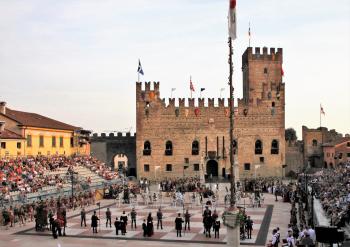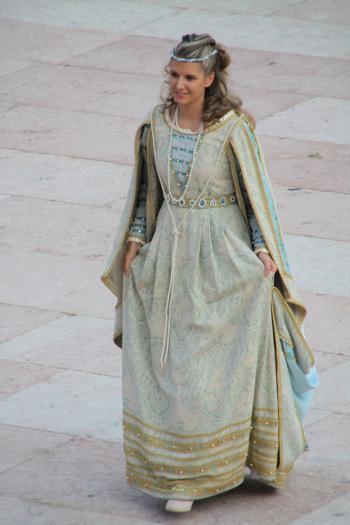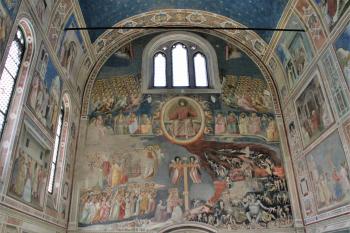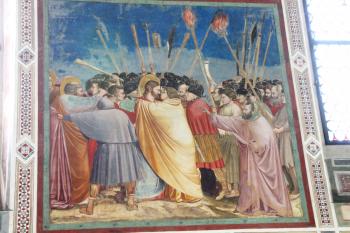Discovering two of Italy’s lesser-known gems
This article appears on page 20 of the May 2018 issue.
France is our favorite country, but in 2016, Italy called my husband, David, and me once again, loud and clear. It was an Emirates nonstop flight to Milan priced at $896 for two that shouted the siren song.
A wonderful surprise
We chose September for our travels because it is our favorite time to visit Europe. The weather is nearly always nice, the crowds are manageable, and the vendange (grape harvest) seals the deal. It turned out that September 2016 held another surprise for us: a human chess game based on a 15th-century legend.
I stumbled upon this event in an old Frommer’s guidebook that I was tearing apart for ease of use. It mentioned that the chess game is held on the second weekend in September during even-numbered years, and we were going to be in the area that weekend!
The Partita a Scacchi di Marostica takes place on the main square of Marostica, a very small town north of Vicenza. Marostica is in a beautiful setting that can be seen from the SP (strada provinciale) 111 on the way from Vicenza to Bassano del Grappa. It is surrounded by a medieval wall that circles up the hill from the Lower Castle to the Upper Castle.
Locals in colorful 15th-century costumes act out the four performances — at 9 p.m. Friday, Saturday and Sunday, with an additional Sunday matinee performance at 5 p.m.
The town square features a giant chess board which, during the Partita, is surrounded on three sides by stadium-style seats. On the fourth side, Marostica’s Lower Castle forms the backdrop of the story.
According to legend, two noblemen fell in love with the beautiful Lionora, daughter of the Lord of Marostica. As was the custom in that time, they challenged each other to a duel. Not wanting to lose either of the young men, Lionora’s father declared that the two rivals should instead play a game of chess, with the winner marrying Lionora and the loser, her sister! The match was to take place on the square in front of the Lower Castle on a feast day.
The experience
And what a feast day we had! Everyone was there, from the court jester to a monk and his donkey to soldiers and ordinary townspeople and musicians and dancers. The performance was so colorful and so picturesque that David took 422 photos!
The show was stolen by the standard bearers, who twirled and threw their flags in a precision aerial ballet before and after the chess game. The show lasted approximately two hours, but the actual chess game took only about 15 minutes.
The 2018 Partita a Scacchi will take place Sept. 7-9. Tickets can be purchased at vivaticket.it and range from €16.50 to €38.50 ($20-$47) for the 5 p.m. Sunday performance to €44-€88 ($54-$108) for the evening performances, which include fireworks.
We attended the Sunday matinee and thought our cheap seats in the Curva ovest (west curve, or corner) were terrific. We booked early enough to get seats at the top, right next to the most expensive seats in the Tribuna platinum section. The bleachers are steep enough to allow everyone a good view. (Beware of the seats on the east side if you are attending the 5 p.m. performance; the sun will be in your eyes.)
There is an excellent video of this event online at vimeo.com/15183578.
Be prepared for TSA-like scrutiny upon entering the square for the show. For some odd reason, they took the top off every water bottle!
Scrovegni Chapel
The second gem of our trip was found in Padua. Fans of Rick Steves and savvy travelers to Italy may well be privy to the charms of Giotto’s Scrovegni Chapel, but it took me by surprise. I would rank this masterpiece right up there with “The Last Supper,” which we had seen two days earlier.
Our travel companions had missed the chapel on a previous trip to Italy and suggested that we include this gem in our itinerary. It turned out to be a terrific suggestion.
The Scrovegni Chapel is like a mini Sistine Chapel, but it is nearly 200 years older.
Don’t make the mistake we did and take the wrong exit off the freeway. We were coming from the west on the A4 and took the first exit. It took us forever to locate the chapel, which is in a pretty park setting on the northeast edge of Padua (Padova in Italian).
The chapel is unassuming from the outside — small and made of brick — but the interior is just the opposite, almost overwhelmingly colorful.
But first you have to get inside. Begin by booking your visit online at least 24 hours in advance at www.cappelladegliscrovegni.it/index.php/en/book-now/information-on-ticke.... Tickets cost €13 ($16) per adult.
Visitors have to pick up their tickets at the Eremitani Civic Museum next to the chapel at least an hour before the appointed entry time. I recommend that you arrive even earlier; there is a lot to see there, including an informative film and exhibits. The more you know about the frescoes before entering the chapel, the better use you can make of your allowed 15 minutes inside.
Note: Visits after 7 p.m. last 20 minutes (when available) or you can pay a little extra for a “double-turn” ticket (phone-booking only, +39049 2010020), which allows you to stay 40 minutes (evening only).
When your group is called, you walk to the chapel. You must be waiting outside the chapel five minutes prior to your appointment.
Like at “The Last Supper,” you are ushered into an air-conditioned anteroom, where you wait for 15 minutes so that you can “dehumidify” before entering the chapel. A video with English subtitles is shown while you sit and wait.
The maximum group size is 25; ours was 21.
The frescoes
The interior was absolutely stunning. Along the side walls were wonderful depictions of scenes from the life of the Virgin Mary followed by scenes from the life of Jesus. You “read” the walls from top to bottom and left to right, starting with the wall on your left (the one with the windows).
The top tier of that wall shows depictions of Mary’s parents, Joachim and Anne, while the top tier on the solid wall presents scenes of the Virgin’s life.
The second tier from the top, on both walls, recounts the life of Jesus, starting with the nativity scene and ending with the money-changers in the temple.
The third tier from the top depicts the Passion and the Resurrection, and the monochrome bottom tier displays vices and virtues painted in trompe-l’oeil.
The arched wall at one end portrays the Annunciation and the Visitation, and the far wall features a very busy Last Judgment, with much rejoicing on the left (the saved) and an extremely graphic representation of the miseries of the damned on the right.
The 15 minutes inside go by fast. I’d recommend taking photos quickly, then standing back against the railing and just gazing at the scenes all around you. You will appreciate it more if you back up to get a full view of the colors, especially the deep blues. The ceiling is covered in brilliant blue, with 8-pointed stars.
No flash photos, no tripods and no large bags are allowed. Bags can be checked at the ticket office.
After your visit, spend a little extra time in the park; we didn’t even know there was a Roman arena there.
Padua, itself, is also well worth visiting. You should not miss St. Anthony’s Basilica, which contains the jawbone, tongue and vocal chords of the silver-tongued St. Anthony, displayed in a gold reliquary. The body of the saint lies in a separate chapel, where the faithful line up to touch the coffin.
Padua’s other “must sees” are the Piazza delle Erbe and the Piazza della Frutta, with their lively produce markets and the beautiful 13th-century Palazzo della Ragione in between; the Piazza dei Signori, with its clothing market, clock tower, Venetian lion and some of the world’s best gelato, and the University of Padua, the second-oldest university in Italy (1222), with its anatomical theater (1595).
Padua is a 30-minute train ride from Venice.




